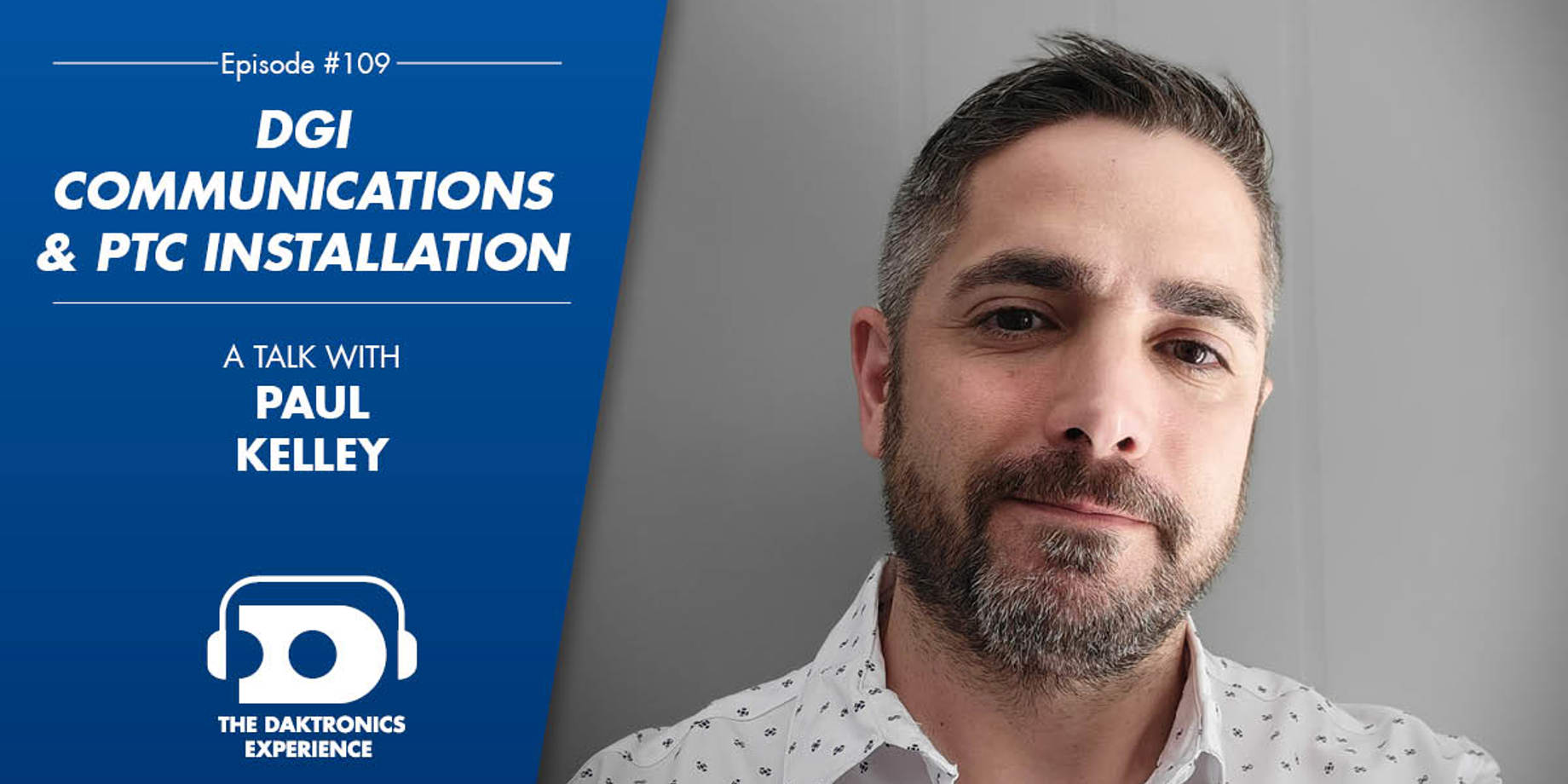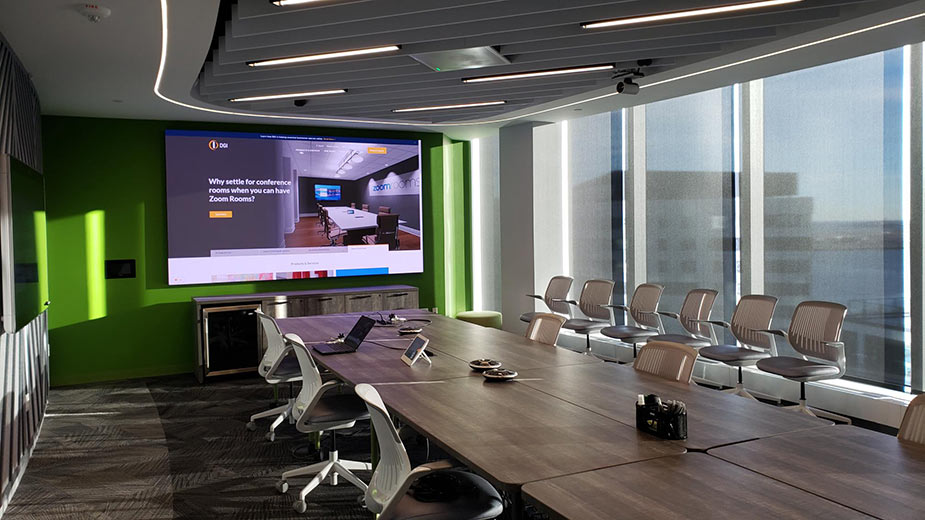Adding a WOW Factor to the Corporate Experience Center at PTC Headquarters
Offices, entryways and lobbies, boardrooms, and other spaces on corporate campuses are stepping up their audiovisual presentations. To hear about those applications from an AV integrator perspective, Justin and Matt are joined by Paul Kelley, Sales Engineer with DGI Communications. Justin: Could you tell us a little bit about your background with DGI Communications? Paul: I started […]
Jennifer Liebschwager on 8/19/2021
Categories:

Offices, entryways and lobbies, boardrooms, and other spaces on corporate campuses are stepping up their audiovisual presentations. To hear about those applications from an AV integrator perspective, Justin and Matt are joined by Paul Kelley, Sales Engineer with DGI Communications.
Justin: Could you tell us a little bit about your background with DGI Communications?
Paul: I started my career in 2003 in IT and at that point in time, the company I was with’s IT department started getting more involved in providing AV services and that gave me exposure to it, and my background of being in IT, I gravitated towards video conferencing and digital signage and streaming. I really fell in love with all that type of stuff and geeked out over it. Since that time, I’ve continued to stay in this space, moving to a field service technician role, then to a sales engineer role and then into my current role at DGI Communications which is part sales engineer, part account management as well.
I generally focus on corporate vertical and they value an integrator that can get technical and get into the weeds with them. DGI got into audiovisual integration around 2008 and our growth has exploded over the past 5 years or so. With a mix of print graphics services and technology services, we can create really great experiences and spaces.

Justin: We recently worked together on a project at PTC headquarters. Can you tell us a little bit about that project?
Paul: PTC is a global computer and software service company with headquarters in Boston. On the 17th floor of their headquarters in Boston is their Corporate Experience Center where they bring their clients in to experience the amazing technology they’re creating. In two of the conference rooms there, they originally built LCD video walls a couple years ago, and they needed to add a WOW factor that they weren’t getting with the LCD. For example, the bezels on the display were minimal, but they were still there.
It came to light that they wanted to be able to see a seamless image when they were doing presentations. So that’s how we settled on a large LED video wall as the right solution.
Justin: Can you describe the location a little bit more and how that factored into their technology decision?
Paul: The Corporate Experience Center is about half of an entire floor and it contains a walking path with different stations, and then there are two larger conference rooms and that’s where the LED walls are. The LED walls are used to transition a customer going through a walking tour to being brought into these conference rooms to sit down and go through whatever resonated on that tour and be shown up on the video wall speaking in more detail about it. So people need to be able to quickly easily go in, have a great experience with the visual, whether it’s a local presentation that’s being done or they’re quickly hopping into a video call as well. At the end of the day, the display has to fit into the space seamlessly both on the screen and fitting in well with the environment, by having a nice frame around it so someone who doesn’t know anything about LED might come into the room and think “how did someone get this gigantic TV in here?”
People need to be able to quickly, easily go in, have a great experience with the visual, whether it’s a local presentation being done or they’re quickly hopping on a video call as well.
Brightness was also another consideration. They had a baseline performance expectation from having the LCDs installed and these displays are installed in outward facing rooms so there’s a decent amount of ambient light that can come into the rooms depending on the time of day, and it’s also on the 17th floor so there are great views of Boston and they don’t want to have room darkening shades pulled blocking the windows all the time. So they needed to make sure that the LED wall that was going in would provide a level of brightness that would be able to punch through the sunlight during business hours. You don’t want to have to wait for rainy days or cover up the nice view to be able to use your technology.

Justin: What was the installation like working with Daktronics?
Paul: Great communication is where a successful installation starts and we had great communication with our Daktronics team. They were fantastic throughout the entire process. One big thing Daktronics brought to the table was a local presence here in Boston, for not only install, but for later down the road should something happen, knowing that we have a local presence here that we can call upon is hugely valuable.
Justin: Moving more towards corporate campuses in general, how have you seen this application change over the years?
Paul: We’ve definitely seen a trend here now for a number of years where boardrooms that a few years ago would have been a projector and projector screen are now becoming LED walls. Prices have come down from where they were and LED technology provides a much more powerful wow factor. Similarly outside of the boardroom, we’re seeing LED disrupt LCD as well, for example in applications like a receptionist’s desk. Where it would have been LCD a few year ago, we’re now seeing more LED. This transition to LED now opens more doors to possibilities create more abstract and cool projects. It doesn’t just have to look like a big TV.
We’re also seeing a big shift to focus on hybrid workspaces and helping clients define and design a corporate strategy. Expectations for hybrid work flexibility have been heightened since the pandemic and everyone home on their web cams, and as some companies go back to the office, they don’t want to go back to this design of a camera in the front of the room providing a far away view of people at the table. They want a more realistic and inclusive experience. So we foresee more installations where LED is being leveraged to create a dual display layout or extra wide, mimicking dual displays on side of walls instead of in front of walls with automated camera tracking, which creates an immersive experience within the calls.
Thanks Paul for joining us and we looking forward to seeing how corporate campuses continue to evolve their use of digital technology! Listen to the full podcast here: http://podcast.daktronics.com/e/109-corporate-campus-applications-with-dgi-communications-paul-kelley/
